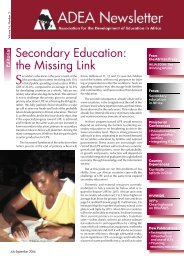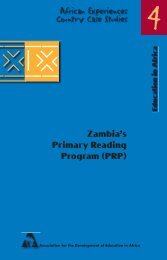Partnerships for Capacity Building and Quality ... - ADEA
Partnerships for Capacity Building and Quality ... - ADEA
Partnerships for Capacity Building and Quality ... - ADEA
You also want an ePaper? Increase the reach of your titles
YUMPU automatically turns print PDFs into web optimized ePapers that Google loves.
ing a much broader look at the effects of activities across whole sectors overtime, <strong>and</strong>, of course, taking into account the totality of external interventions.New types of evaluation are required <strong>and</strong> these are under consideration. Whetherthematic, sectoral or multi-donor, they must be shared by all partners in thedebate.Lesson 4: From crisis management to partner indevelopmentThe Sahel experience shows that the approaches <strong>and</strong> instruments of aid aretoo often linked to crisis situations where donor agencies become executingagents using relatively st<strong>and</strong>ardised methods. To be sure, the international communityhas several times been faced with major emergencies, such as food crisesor the financial crises of the 1980s, that threatened to overwhelm Sahel societies.In such cases, where the goal was to manage extreme situations (<strong>and</strong> preventtheir recurrence), the aid system intervened promptly in a massive, <strong>and</strong> sometimesauthoritarian way.Aid designed to improve Sahel capacities <strong>and</strong> develop opportunities must,however, respect a different rhythm. It is a never-ending process. Instead of leading,aid must accompany. Instead of transmitting messages or goods, it shouldpropose choices. There is too often a tendency to consider each Sahel village,economic activity or administrative service as an institution in crisis that absolutelymust be re<strong>for</strong>med according to external designs, applied, as necessary,through systems of financial incentive.Funding agencies now agree that capacity building <strong>and</strong> institutional developmentare major factors in development. But do they possess the proven instrumentsneeded to assist in these areas? The review of experiences in the regionshows that classic aid interventions have produced limited results. It is not enoughto stress institutional development. This must be accompanied by ef<strong>for</strong>ts todevise innovative methods <strong>and</strong> instruments capable of tackling this question inthe future.Conclusion: A necessary restraint?The malfunctioning of the aid system in practice must be put in perspective.It should not hide the results obtained but should nevertheless be taken veryseriously. Aid cannot be sustained unless it wins the approval of Sahel <strong>and</strong>western actors alike.If aid ef<strong>for</strong>ts have failed in the past, this was often due to excessive interventionism.In the Sahel region, aid has occupied a place that is too important <strong>and</strong>too central. The desire to assist, to re<strong>for</strong>m, <strong>and</strong> to fund has sometimes prevailedover the need to respect the fragile structures of trans<strong>for</strong>mation within Sahelsocieties.ADAPTING AGENCY SOLUTIONS TO COUNTRY PROBLEMS 41

















